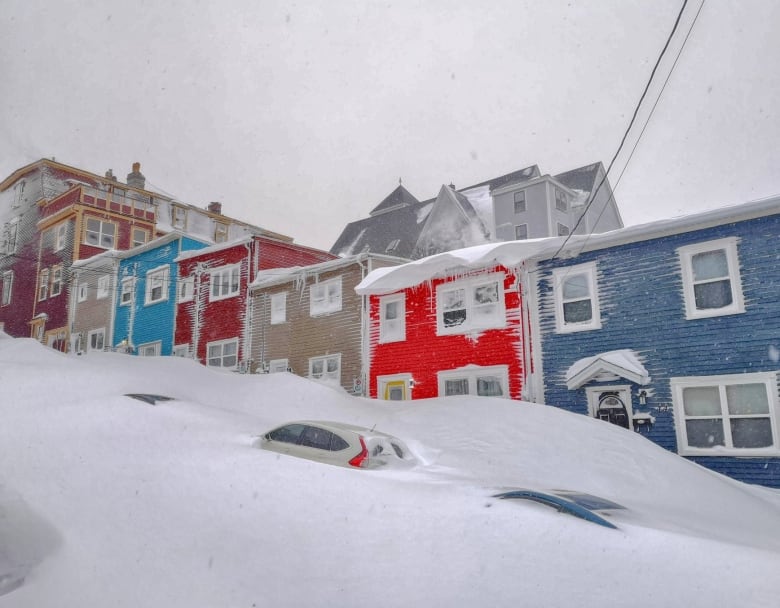Cabin fever sets in during historic blizzard — but there are tips for how to cope
While not an official diagnosis, the symptoms of cabin fever are very real

As the wind shook the windows in their frames and her husband's seizures intensified, Kim Dunphy began to panic in her Bay Bulls home.
Cut off from the hospitals in the nearby capital city by a dense blanket of snow, they were all alone.
"With his seizures, I know I don't always have to call 911. But I'm just wondering if the next seizure is going to be one where I have to call 911."
And if so, would anyone be able to come?
While the blizzard — and its days-long aftermath — has been a bonding experience for some, it has been isolating and anxiety-ridden for others.
Kim Dunphy suffers from post-traumatic stress disorder. Her husband was left partially paralyzed after a workplace incident on the Hibernia platform. He also has epilepsy.

The Dunphy family is used to having their mobility limited in the winter, but being trapped indoors for the last four days has been a much worse experience.
"Every time that I'd find myself getting stressed, I'd realize that I'd have to divert myself to something else or I was going to lose it," Kim Dunphy said.
Cabin fever is real
While cabin fever isn't a formal diagnosis, psychologist Janine Hubbard said it's a common condition people experience while being trapped in one place for an extended period of time.
Most people will experience irritability, and see changes to things like sleeping and eating patterns. For others, however, the symptoms of cabin fever can be much worse.
"For people who perhaps have underlying anxiety and panic disorders, this can be a major trigger," Hubbard said.
One of the things she recommends is keeping your mind busy.

That's exactly what Kim Dunphy did.
"At some point, you have to try to take control of it," Dunphy said. "If I couldn't help myself, maybe I could help someone else."
Dunphy went on social media and began searching the Facebook pages related to the storm. She found someone who was asking for people to check on a relative in the Bonavista area. Dunphy was hundreds of kilometres away, but began sharing the post on Twitter.
"We put out the call and a lot of people retweeted it and we got help for this lady in the community," she said.
As of Monday morning, Pat Dunphy had suffered three seizures since the state of emergency was first called. They were still trapped due to a flat tire on their wheelchair-accessible van, but were touched to see people in the community dig out their driveway.
Riding it out alone
Kaiden Dalley spent 40 hours without power, alone, and trying to deal with an illness.
The result was an increased level of anxiety stemming from the loneliness and fear from the storm.
"It was very isolating and it just kind of changes your perspective a bit when you have such limited contact to the outside and it's cold, and lonely, and dark."
On Saturday, Dalley could see through the snow in the window and see people digging out but felt helpless as they remained trapped inside.
"Because of an illness I've been facing, I wasn't able to shovel myself out so I had to just kind of wait for somebody to come along and help out."

Dalley coped by using the little bit of cellphone battery remaining to make some five- or 10-minute phone calls to have social interactions.
After being trapped inside throughout the 40-hour power outage, a friend managed to reach Dalley for a rescue.
"Being stuck in that situation for so long ... I think the biggest relief was being able to talk to somebody and remove myself from where I was."
Dalley has experienced cabin fever before, especially during a long hospital stay a few weeks ago, but never anything like this.
"That was nothing compared to these couple days. Even though the time was shorter, it was much, much different."
What can you do?
There are a few ways to stave off what is commonly referred to as cabin fever.
"Work on active distraction," Hubbard said. "The biggest thing is to work your brain when you start to feel cabin fever."
Mindless distraction is one thing — bingeing movies and TV shows — but active distraction could include things like puzzles, board games and stress-reducing apps.
That's advice that could become increasingly important for parents, as the Newfoundland and Labrador English School Distrcit announced its metro-area schools would remain closed for the rest of the week, to allow for cleanup efforts.
Hubbard said it's also important to reach out to their neighbours, even if they don't think the person is prone to mental health problems. Isolation and a violent storm can leave anybody with ill effects.
"People often make assumptions about their neighbours and think 'Oh, they're fine, they've got things together.' Reach out. People will come to your help. You will not be judged, you will not be shamed. People are looking to channel their energy in this storm to do something useful, to feel productive."
